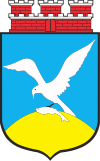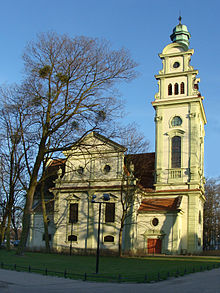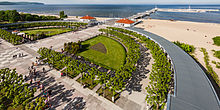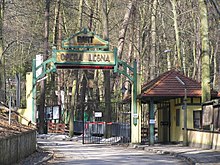Sopot
| Sopot | ||
|---|---|---|

|
|
|
| Basic data | ||
| State : | Poland | |
| Voivodeship : | Pomerania | |
| Powiat : | District-free city | |
| Area : | 17.31 km² | |
| Geographic location : | 54 ° 26 ' N , 18 ° 33' E | |
| Residents : | 35,827 (Jun. 30, 2019) |
|
| Postal code : | 81-701 to 81-806 | |
| Telephone code : | (+48) 58 | |
| License plate : | GSP | |
| Economy and Transport | ||
| Street : | Gdynia - Gdansk | |
| Rail route : | Gdynia – Danzig | |
| Next international airport : | Danzig | |
| Gmina | ||
| Gminatype: | Borough | |
| Surface: | 17.31 km² | |
| Residents: | 35,827 (Jun. 30, 2019) |
|
| Population density : | 2070 inhabitants / km² | |
| Community number ( GUS ): | 2264011 | |
| Administration (as of 2014) | ||
| City President : | Jacek Karnowski | |
| Address: | ul.Kosciuszki 25/27 81-704 Sopot |
|
| Website : | www.sopot.pl | |





Sopot [ ˈsɔpɔt ] ( German Sopot ) is a Baltic Sea resort in the Polish Pomeranian Voivodeship . Together with Danzig ( Gdańsk ) and Gdynia ( Gdynia ) it forms the Tricity conurbation ( Trójmiasto in Polish ). While trade, industry and ports are of particular importance in the two neighboring cities, Sopot, as a spa town, benefits primarily from tourism .
Geographical location
The bathing and health resort is located in the historical West Prussian landscape , on the west coast of the Gdansk Bay , about nine kilometers northwest of Gdansk and nine kilometers south of Gdynia .
history
The word Sopot is of Slavic origin and means source . As a small fishing village, Sopot had belonged to the Oliva Cistercian since 1283 and, like all of the monastery's own localities opposite Danzig, was obliged to serve as a castle; from 1283 to 1807 it belonged to the Hanseatic city of Danzig. The history of Sopot is therefore closely linked to the history of the city of Danzig , which fell to the Teutonic Order State of Prussia in 1308 together with Pomeranians and after 1466, while maintaining its sovereignty and population, belonged to the Prussian royal share , which voluntarily came under the patronage of the Crown of Poland, that is, the king personally.
On the occasion of the establishment of the Union of Lublin in the Lublin Sejm announced King Sigismund II. August on 16 March 1569 the autonomy of West Prussia, however bitter under penalty sanctions unilaterally, which is why the supremacy of the Polish king in this part of the former territory of the German Order of 1569 until 1772 was perceived as foreign rule.
In 1668 a woman in Sopot was accused of witchcraft who was killed in a witchcraft trial .
As part of the first division of Poland in 1772, the area around Putzig and Sopot came under Frederick II of Prussia to the Kingdom of Prussia . In 1785 Sopot is described as a royal village on the Baltic Sea with 38 fireplaces (households).
In 1819, the administrator of the domain office in the village of Brück , about 19 kilometers further north , Friedrich Gütte , who had been fascinated by the beauty of the natural surroundings on the Bay of Danzig , decided to convert the fishing village of Sopot into a seaside resort. To this end, in the same year he moved the domicile of the domain office district from Brück to Sopot and initiated appropriate administrative measures there. In 1823, the Alsatian doctor Johann Georg Haffner , who had come to Gdansk in 1808 as a surgeon for the Grande Armée Napoleon Bonaparte , married there and settled in Sopot, opened the first lido with spa sanatorium . Sopot turned out to be a good health resort for those looking for relaxation, because wooded mountain ranges protect the place from north and west winds, the air is mild and mosquito-free and the sea water in the Gdańsk Bay is slightly warmer and has a significantly lower salt content than in the western part of the Baltic Sea . Since the start of the spa business , Sopot has steadily developed into a fashionable seaside resort .
From 1871 to 1920 Sopot belonged to the German Empire . The Zoppoter Zeitung was published in 1894 .
By a decree of Kaiser Wilhelm II. Of October 8, 1901, the rural community of Sopot was allowed to adopt the city regulations from April 1, 1902. As a city, Sopot belonged to the Neustadt district in West Prussia . The approximately 14,000 inhabitants (1910) were divided between the former upper village - near the railway line and along Danziger Chaussee - and the lower village , the villa and hotel district near the beach.
On the VI. German Esperanto Congress In 1911 in Lübeck , Sopot was chosen to host the VII German Esperanto Congress of Germana Esperanto-Asocio (GEA) .
The city had a high school and a small Protestant church. There was a horse racing track, which was maintained by the West Prussian Riding Club, as well as a cycling track. The building complex with Kurhaus and lodging house erected at Seesteg between 1909 and 1911 , of which only the lakeside front of the Kurhaus remained and was integrated into a modern new building, had a casino from 1919 . Before the First World War , Sopot Week took place every year in mid-July with a series of sporting competitions. These included horse races, bicycle races, an open sailing regatta, the East German tennis tournament, for which Kaiser Wilhelm II donated a prize every year, and swimming events. In August, further events such as theater performances and dog races took place to entertain the approximately 15,000 bathing and spa guests annually. Poles and Russians made up the largest contingent of non-German bathers. From 1924 to 1927, the luxurious casino hotel, which has since been renamed the Grand Hotel , was built north of the Großer Seesteg and still characterizes the beach.
When the League of Nations formed the Free City of Danzig on January 10, 1920 based on the provisions of the Versailles Treaty ( Article 100-108 Section XI, Part III VV), the city of Sopot was next to the city of Danzig and the districts of Danziger Höhe , Danziger Niederung and Großes Werder (including the cities of Tiegenhof and Neuteich ) integrated into the Danzig state. Sopot was part of the Danziger Höhe district for a short transition period before it was elevated to the status of an urban district on March 15, 1920 . Sopot was now directly on the border to the Polish corridor established by the Reich territory on the basis of the provisions of the Versailles Treaty , with the transition to Koliebken in the corridor. A smaller area of Koliebken, only 3.34 hectares in size, was not part of the corridor when the border was drawn and was annexed to Sopot on May 6, 1922.
Between the world wars, the ships of the East Prussian sea service docked in Sopot.
After the invasion of Poland in 1939, Germany annexed the area of the Free City of Danzig. It was assigned to the Reichsgau Danzig-West Prussia , to which Sopot belonged until 1945.
Towards the end of the Second World War , units of the Red Army approached the city of Sopot from the west on March 19, 1945 . Towards evening eviction orders were issued for civilians, who then fled by the thousands to Gdynia . Others used a shuttle service from the pier to Danzig- Neufahrwasser . From March 20, 1945 Sopot and Oliva came under artillery fire, about 10% of which was destroyed. The German troops withdrew, and on the evening of March 23, 1945, the Red Army occupied Sopot without major fighting. The Soviet Union placed the area of the Free City of Danzig, including Sopot, under the administration of the People's Republic of Poland , which incorporated it into the newly created Województwo gdańskie ( Voivodeship of Danzig ) on March 30, 1945 .
The Potsdam Agreement of August 2, 1945 confirmed in Article IX. this step. Sopot was renamed Sopot .
In Sopot, the immigration of Poles began, who moved into the abandoned houses. Most of them came from central Poland. The local residents of the Free City of Danzig were expelled in several steps until 1946, with the exception of a small residue who had proven their "belonging and loyalty to the Polish nation" .
Population development
| year | Residents | Remarks |
|---|---|---|
| 1869 | 1,204 | |
| 1871 | 1,487 | in 230 inhabited houses |
| 1875 | 2,834 | |
| 1880 | 3,543 | |
| 1890 | 4,722 | |
| 1910 | 15,015 | |
| 1929 | 30,835 | |
| 1941 | 27,971 | |
| 1945 | 21,154 | 15,154 Poles, 6,000 Germans (as of November 1, 1945) |
| 2012 | 38,426 | As of June 30, 2012 |
Attractions
The cityscape is characterized by buildings from the 19th and early 20th centuries and spa facilities.
- The town hall was built in 1910/1911 according to a design by Paul Puchmüller (1875 Stolp - 1942 Sopot; 1901 to 1922 city architect of Sopot) and expanded in 1922/1923.
- A memorial plaque commemorates the synagogue built by Adolf Bielefeldt in 1913/1914 and burned down by the National Socialists on the night of November 12th to 13th, 1938 .
- The pier , a 511.5 meter long wooden pier into the Gdańsk Bay, official name until 1945, Großer Seebesteg , now called Molo , with restaurants and mooring for small boats and excursion boats.
- The Crooked House (Krzywy Domek) , a 21st century building.
- The Jewish cemetery has the only preserved entrance portal with a Hebrew inscription in the Pomeranian Voivodeship.
Churches
- Evangelical Lutheran Church of the Savior (Kościół Zbawiciela) , seat of the bishop of the Pomeranian-Greater Poland diocese , built from 1913 to 1919 by the Danzig architect Adolf Bielefeldt (1876 Herne - 1934 Danzig) in neo-baroque style
- Catholic Church of St. George (Kościół garnizonowy św. Jerzego) , built from 1899 to 1901 as a Protestant Church of the Redeemer with a 47 meter high tower in the neo-Gothic style based on a design by the architect Ludwig von Tiedemann
- Catholic Church Maria Meeresstern (Kościół parafialny NMP Gwiazdy Morza) , built in 1901/1902, neo-Gothic .
- Catholic Church of St. Andrew Bobola (Kościół parafialny św. Andrzeja Boboli) , the neo-Gothic chapel of the Assumption was built in 1869/1870 and consecrated on August 14, 1870. It was expanded from 1984 to 1988 to include today's parish church.
Culture
Museums
- Museum of Sopot (Muzeum Sopotu), founded in 2001, with an exhibition in the restored Villa Ernst Claaszen (built in 1903/1904) on home decor at the beginning of the 20th century and on local and regional history.
- Archaeological open-air museum - “Grodzisko” castle complex
- Sopot Wax Museum
Theaters and stages
Events
- Sopot Festival
- The Cartoon Forum took place in Sopot from 13 to 16 September 2011. The largest film and rights market for animation TV series in Europe.
Sports
The ATP tennis tournament ATP Sopot took place in Sopot every year until 2008 . With Prokom Trefl Sopot , the city of Sopot now has one of the best European basketball clubs. Sopot was the venue for the final round of the FIVB Men's Volleyball World League 2011. In 2014, the 15th World Indoor Athletics Championships were held in the Ergo Arena, which opened in 2010 . Sopot is also a venue for the 2014 Euro Beach Soccer League.
Town twinning
- Ashkelon , Israel
- Frankenthal , Germany, Rhineland-Palatinate since April 17, 1991
- Karlshamn , Sweden
- Naestved , Denmark
- Peterhof , Russia
- Ratzeburg , since June 4, 1994, Germany
- Southend-on-Sea , United Kingdom
- Zakopane , since March 20, 1993, Poland
Personalities
sons and daughters of the town
- Tadeusz Aziewicz (* 1960), politician of the Platforma Obywatelska
- Andreas E. Beurmann (1928–2016), German musicologist
- Marek Biernacki (* 1959), 1999–2001 Minister of the Interior of Poland
- Viktor Böttcher (1880–1946), National Socialist politician
- Winfried Glatzeder (* 1945), German actor
- Fritz Heidingsfeld (1907–1972), German painter, glass painter, etcher and draftsman for Gobelins
- Friedrich Georg Houtermans (1903–1966), physicist
- Wolfgang Kalähne (* 1945), flotilla admiral ret. D.
- Klaus Kinski (1926–1991), German actor
- Wilhelm Koepp (1885–1965), German theologian and professor of German Christians
- Janusz Pawłowski (* 1959), judoka
- Paul Serotzki (1887 – after 1950), communist politician
- Janusz Śniadek (* 1955), union official
- Carl Maria Splett (1898–1964), Bishop of Danzig
- Jacek Tylicki (* 1951), artist
- Alfred Werner (1892–1980), German philosopher and university professor
- Marcin Zamoyski (* 1947), mayor of Zamość , voivode ibid
Persons connected with Sopot
- Johann Georg Haffner (1775–1830), doctor from Colmar, pioneer of the spa business at the seaside resort
- Friedrich Gütte (1779–1843), Prussian domain office district administrator, initiator and planner of the seaside resort of Sopot
- Stefania Łukowicz-Mokwa (1892–1975), Polish musician
- Marian Mokwa (1889–1987), Polish painter and honorary citizen
- Donald Tusk (* 1957), Polish politician
Honorary citizen
- Tadeusz Gocłowski (1931-2016), Archbishop of Gdansk (2008)
Pastors and martyrs
- Walter Hoeft (1906–1939), vicar , shot in 1939, Piaśnica massacre
- Konstantyn Krefft (1867–1940), pastor, died in 1940 in the Stutthof concentration camp
- Jerzy Majewski (1904–1942), vicar, died in 1942 in Dachau concentration camp
- Władysław Szymanski (1901–1940), clergyman, shot in 1940 in the Stutthof concentration camp
- Robert Wohlfeil (1889–1940), pastor, died in 1940 in Sachsenhausen concentration camp
City leaders
- 1900–1905 Volkmar Wurmb (1853–1905), mayor of the community, from 1902 mayor
- 1905–1908 Johannes Kollath (1871–1908), mayor
- 1908 Government Assessor Heinrich von Gagern (1878–1964; center ), acting
- 1908–1919 Max Woldmann (1868–1919), mayor
- 1919–1930 Erich Laue (1879–1933), from 1920 mayor
- 1930–1934 Hermann Lewerenz (1893–1939), Lord Mayor
- 1934–1936 Wilhelm Fließbach , Lord Mayor
- 1936–1941 Erich Temp (1904–1945), Lord Mayor
- 1941–1942 Gerhard Koß, executive mayor, mayor 1936–1941
- 1942–1943 Kurt Schrödter, executive mayor
- 1943–1945 Wolfgang von Tobien, executive mayor
- February / March 1945 Hermann Jacob, Executive Mayor
- 1945 Henryk Michniewicz (1907–1956), Burmistrz, later prezydent (President)
- 1945 Tadeusz Soboń , prezydent
- 1946 Antoni Turek (1907–1996), prezydent
- 1946–1948 Leonard Wierzbicki (1888–?), Prezydent
- 1948 Srebrnik, prezydent
- 1948 Bolesław Śliwiński , prezydent
- 1948–1949 Jan Kapusta (1908–1953), prezydent
- 1949–1950 Piotr Nowak , prezydent
- 1950–1952 Alfred Müller (1905–1980), initially prezydent, still 1950 przewodniczący Miejskiej Rady Narodowej (Chairman of the National City Council)
- 1952–1954 Hieronim Kozieł (1910–1970), przewodniczący
- 1954–1958 Roman Kosznik (1927–1974), przewodniczący
- 1958–1965 Stanisław Podraszko (1911–1973), przewodniczący
- 1965–1969 Zenon Bancer , przewodniczący
- 1969–1978 Bolesław Robakowski , przewodniczący, from 1973 again prezydent
- 1978–1981 Lech Świątkowski , prezydent
- 1981–1984 Cezary Dąbrowski (* 1941), prezydent
- 1984–1990 Andrzej Plona , prezydent
- 1990–1992 Henryk Ledóchowski (* 1944), prezydent
- 1992–1998 Jan Kozłowski (* 1946), prezydent
- 1998– Jacek Karnowski (* 1963), prezydent
gallery
literature
(in chronological order)
- Notes about the seaside resort of Sopot. In: Prussian provincial sheets. Volume 17. Königsberg 1837, pp. 222-227.
- Halffter: Notes on the effects and success of the seaside resort of Sopot near Gdansk. In: Prussian provincial sheets. Volume 17. Koenigsberg 1837, pp. 551-554.
- Johann Eduard Boettcher: The seaside resort of Sopot near Danzig in historical, topographical, statistical, scientific and social terms; its legends and its effectiveness as a medical establishment. With maps and explanatory drawings. Danzig 1842 ( digitized from Google Books ).
- Hans Prutz : History of the Neustadt district in West Prussia . Danzig 1872 ( digitized from Google Books ).
- Franz Schultz : Chronicle of the town of Seebad Soppot. AW Kafemann, Danzig 1905 ( digitized version ).
- Ernst Bahr: Sopot. In: Handbook of historical sites , East and West Prussia. Kröner, Stuttgart 1981, ISBN 3-520-31701-X , p. 246.
- Olga Kurilo: Sopot, Cranz, Rigascher Strand: Baltic seaside resorts in the 19th and 20th centuries. be.bra Wissenschaft verlag, Berlin 2011, ISBN 978-3-937233-81-9 , pp. 45–76.
Web links
- Official website of the city of Sopot (Polish)
- Sopot . In: Danzig.info
- Sopot . In: Polish-Online.com
- Sopot . In: Poland.Travel
- Paweł Mehring: Sopot / Sopot . In: OME-Lexikon
- Information brochure about Sopot (PDF)
See also
Individual evidence
- ↑ a b population. Size and Structure by Territorial Division. As of June 30, 2019. Główny Urząd Statystyczny (GUS) (PDF files; 0.99 MiB), accessed December 24, 2019 .
- ^ Maria Malec, Słownik etymologiczny nazw geograficznych Polski
- ^ Hans Prutz : History of the Neustadt district in West Prussia . Danzig 1872, p. 33.
- ^ Max Toeppen : Historisch-comparative geography of Prussia. Gotha 1858, p. 44.
- ^ Hans Prutz: History of the Neustadt district in West Prussia . Danzig 1872, p. 104.
- ^ Hans Prutz : History of the Neustadt district in West Prussia . Danzig 1872, p. 151.
- ^ Johann Friedrich Goldbeck : Complete topography of the Kingdom of Prussia . Part I, Königsberg / Leipzig 1785, Complete Topography of the West Prussian Cammer Department , p. 207.
- ↑ Baltic resorts and cities on the Baltic coast (= Meyer's travel books ). 4th edition, Bibliographische Institut, Leipzig / Vienna 1910, pp. 171–175.
- ^ Address book for the city of Sopot. Hans Groddeck printing works, Sopot 1917.
- ^ From the history of the town of Sopot on the Baltic Sea. In: Gdansk residents' book from 1942, Part V: Sopot.
- ↑ a b Stadtkreis Soppot , on: Territorial changes in Germany and areas under German administration: 1874–1945 , accessed on October 7, 2011.
- ↑ a b c d e Battle of Danzig , on: 389th Infantry Division , accessed on October 6, 2011.
- ^ Peter Oliver Loew : Danzig. Biography of a city. CH Beck, Munich 2011, ISBN 978-3-406-60587-1 , p. 231 ff.
- ↑ a b Handbook of Historic Places, East and West Prussia. Kröner, Stuttgart 1981, ISBN 3-520-31701-X , p. 246.
- ^ Hans Prutz : History of the Neustadt district in West Prussia . Danzig 1872, pp. 234-235, no. 214 .
- ^ A b c Michael Rademacher: German administrative history from the unification of the empire in 1871 to the reunification in 1990. Province of West Prussia, Neustadt district. (Online material for the dissertation, Osnabrück 2006).
- ↑ gemeindeververzeichnis.de, community directory Germany 1900, district Neustadt (West Prussia)
- ↑ Stadtkreis Soppot: Footnote 1. In: Territorial.de. Retrieved September 8, 2018 .
- ^ Sylwia Bykowska: The Rehabilitation and Ethnic Vetting of the Polish Population in the Voivodship of Gdańsk after World War II . Peter Lang Publishing Group , 2020, ISBN 978-3-631-67940-1 , p. 116 (English).
- ↑ Population statistics of Poland from June 30, 2012: Table 7, p. 43 (Polish; PDF)
- ^ Molo of Sopot. In: Molo.Sopot.pl. Retrieved August 22, 2018 .
- ↑ http://www.sopot.luteranie.pl/
- ↑ Archived copy ( Memento from June 6, 2013 in the Internet Archive )
- ↑ Archived copy ( Memento from September 14, 2011 in the Internet Archive )
- ↑ Archived copy ( Memento from September 23, 2011 in the Internet Archive )
- ↑ Archaeological open-air museum - “Grodzisko” castle complex. In: Archeologia.pl. Retrieved September 2, 2018 .
- ^ Official website of the Sopot Wax Museum
- ↑ Cartoon Forum in Gdansk & Sopot. In: Bedouk.com. May 8, 2011, accessed September 14, 2018 .
- ↑ Café Kinski was opened in the house where he was born in Sopot in the 1990s .
- ↑ In Sopot a memorial has been commemorating these five martyrs of the Catholic Church and 69 other citizens of the city since 1985 . [1] ( Page no longer available , search in web archives )
- ↑ Gagern was later District Administrator in Melsungen (1914-1919 and 1933-1937), District Administrator in Fulda (1921-1933). Cf. The Protocols of the Prussian State Ministry: 1817–1934 / 38 (12 vols., = Acta Borussica; new series). Ed .: Berlin-Brandenburg Academy of Sciences. Olms-Weidmann, Hildesheim / New York / Zurich 2001–2004, Vol. 11, Part II: November 14, 1918 to March 31, 1925 (2002), arr .: G. Schulze, ISBN 3-487-11663-4 , P. 577.
- ↑ a b c d e f Raimund Glembin, Józef Golec: Poczet Ojców Miasta Sopotu (The series of heads of towns in Sopot). Cieszyn 2016, ISBN 978-83-943511-3-7 , pp. 165f.













